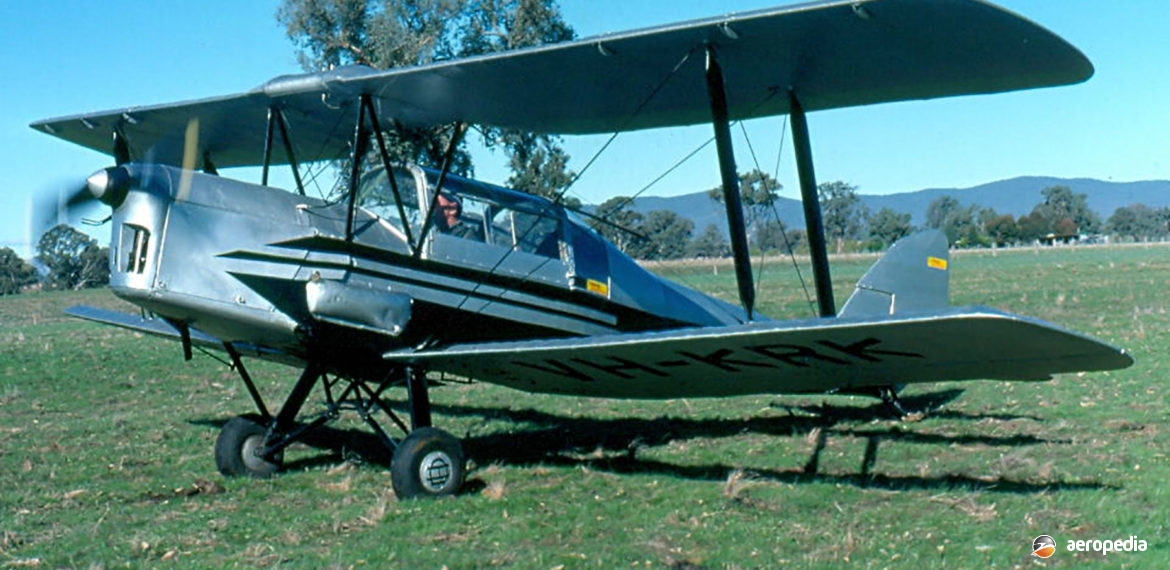Photograph:
Wiltshire Jackaroo VH-KRK (c/n 83314) at Wodonga, VIC in June 1981 (David C Eyre)
Country of origin:
United Kingdom
Description:
Four-seat cabin biplane
Power Plant:
One 87 kw (130 hp) de Havilland Gipsy Major 1 four-cylinder in-line air-cooled engine
Specifications:
- Wingspan: 9.25 m (30 ft 4½ in)
- Length: 7.85 m (25 ft 9 in)
- Height: 2.69 m (8 ft 10 in)
- Wing area: 22.92 m² (246.7 sq ft)
- Max speed: 167 km/h (104 mph)
- Economical cruising speed: 137 km/h (85 mph)
- Stalling speed: 60 km/h (37 mph)
- Initial rate of climb: 183 m/min (600 ft/min)
- Range: 400 km (250 miles)
- Empty weight: 617 kg (1,360 lb)
- Loaded weight: 989 kg (2,181 lb)
History:
The Jackaroo was developed by the Wiltshire School of Flying Limited at Thruxton Aerodrome, Andover, Hampshire in the United Kingdom in the early 1960s. It was a low-cost conversion to four-seat configuration of the de Havilland DH.82 Tiger Moth. Looking very much like a Tiger Moth with an enclosed canopy, the Jackaroo had the fuselage widened at the cockpit area to accommodate four-seats in two pairs. The first conversion was a four-seat Series I (G-AOEX) which flew on 2 March 1957. It is believed some 18 DH.82s were converted by Jackaroo Aircraft Ltd at Thruxton in Hampshire between 1957 and 1959. Another (G-APOV) was completed by Rollasons in 1990. Kits were made available so overseas DH.82 owners could convert their own aircraft but it is not believed any others were converted.
The overall width of the fuselage was widened to 0.91 m (3 ft) as compared to the normal 0.6 m (1 ft 11 ½ in). Two variants were produced: the Mk I a standard four-seat conversion; and the Mk II equipped for agricultural duties with modified top decking. First example of the latter was G-AOEY. In the Mk II the passenger seats were replaced by a tank for chemicals, and spray-bars were fitted under the wings, the aircraft being a single-seater. The aircraft was normally known as the Wiltshire Jackaroo, but has also been known as the Thruxton Jackaroo.
A number of conversions were carried out, and several of these being delivered to India and Spain, with deliveries of production aircraft commencing in February 1961. Normal welded steel-tube construction as used in the DH.82 was used, and an additional steel-tube was inserted in the fuselage forward of the centre-section wing struts so that the engine was mounted further forward to offset the greater weight aft of the centre of gravity. The new structure employed existing fuselage fittings and the dual controls were maintained in tandem. Entry was via hinged doors. No modifications were made to the wings, interplane struts, tail surfaces or rear fuselage, but the increase in width of the fuselage required an extension of the centre-section, thus increasing the wingspan.
Two examples have been imported to this region. VH-KRK (c/n 83314), which appeared on the register as a ‘DH.82A Thruxton Jackaroo’, was first registered on 24 January 1979, was based in Victoria in its early life and for some years was used for joy-riding from Cairns in North Queensland. In 2005 it was exported to the United Kingdom.
In 2011 a damaged Jackaroo was imported to Victoria for rebuild as a restoration project. The aircraft was built in 1939 for the RAF as a standard DH.82A serial 82151. After retirement it was purchased in 1957 by the Wiltshire School of Flying at Thruxton and was the tenth production Jackaroo. It was registered in the United Kingdom as G-AOIO. However, restoration was not completed in Australia and was shipped to New Zealand in 2017 where restoration was completed at Tauranga and became ZK-PHZ in January 2020.

